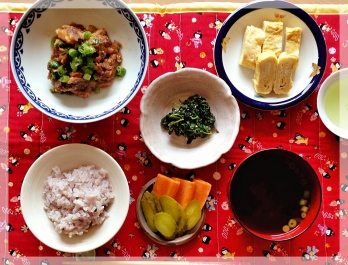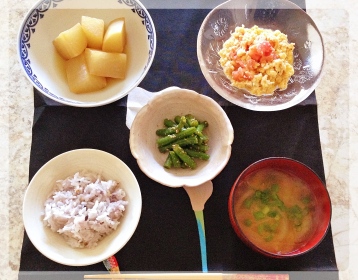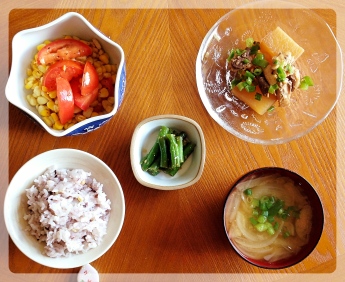There are many different meanings of “HEALTHY” for each person. Having good nutrition, being positive, being powerful, building up muscles, losing some weight… Also there are many ways to be healthy. Exercise, diet, meditation, sleep…
Today’s post is for people struggling with becoming healthier, but it doesn’t recommend a one size fits all solution about what to do and how to do it. The post is based on my study, research and real-life experiences.
My suggestion to all of you who want to lead a healthy life is that
“You can eat anything you want. But it must be WELL-BALANCED!!”
In your meals, you have to include many COLORFUL ingredients, some different COOKING METHODS and some different TASTES in dishes, and the dishes have to be served in SMALL PORTIONS which you can grab with a hand.

[Colorful ingredients] Red, Yellow, Green, White, Brown, Purple…
[Cooking methods] Raw, Fermented, Simmered, Boiled, Steamed, Roasted, Grilled, Sautéed, Fried…
[Tastes] Sour taste, Savory, Bitter taste, Pungent taste, Sweet-savory, sweet taste…
[Other suggestions] Only ONE dish of carb (Rice, bread or noodles) in a meal. CHEW well. Not too much fried food.
For example, one day my meals consisted of:
Steamed multigrain rice: Steamed, Carb
Onion miso soup: Fermented, Savory
Simmered Daikon: Simmered, Sweet-savory
Scrambled egg and tomato: Pan-fried, Spicy taste
Boiled green beans with sesame dressing: Boiled, Sour taste

This is what I learned by watching my mother cook so it is easy for me, but I know it is not easy for people who are not used to these sorts of multiple small dishes.
Here are some tips:
*Prepare some dishes ahead of time when you have any spare time. In my recipes, there are a lot of main dishes and side dishes, which can be stored in the refrigerator for 2-5 days or for much longer in the freezer. You don’t need to cook a lot each time.
*If you have to eat one dish as a quick lunch, you can adjust your dinner appropriately.
*If you have to eat out for dinner, you can adjust your breakfast and lunch in advance.
This well-balanced cooking also saves you money in your grocery budget and minimizes wasted food because you know your meal composition in advance so you can buy the minimum foodstuffs.
When I was in Japan, I always followed this well-balanced meal composition for my breakfast and lunch. For dinner I often ate out with my co-workers, which meant dinner was not always well-balanced, but at least 2 out of 3 meals were balanced everyday. In addition, I was too busy to work out so I did Yoga for 30 minutes once a week and I had Taiko (Japanese Drum) lessons for 90 minutes twice a month, and that’s it. I was 5.4ft. and 120lb.
After I moved to the US with my husband, we have always worked out 3 times a week (weights, stretching and cardio), and we always eat healthy (salad, soup, chicken, no flour, no fried food… but its still not like the meal composition in Japan). Before I knew it, I gained 15 lb., which may not have been all fat because I did build some of my muscles up.
Still, it was a lot of weight for my frame. So I started my traditional Japanese cooking for most meals. After a week I stopped between-meal eating. After two weeks, I stopped craving snacks or junk food. After three weeks, I lost 7 lb. naturally. Of course, the meals I ate easily make me full so I am not hungry and constantly craving food. My mother and grandmother always said that our brain doesn’t signal us to eat more when our body absorbs varied and good amounts of nutrition. And it happened to me. It is true!!
In addition, when I have these well-balanced meals, I feel very happy, very powerful and have very positive thinking. When we eat a lot of unhealthy food and don’t work out we lack energy, we crave more food and also we have greater risk for many lifestyle-related diseases.
If you want to have pizza, you can have one piece of pizza as a carb, plus your meat with some small portion side dishes which are cooked with various cooking methods and which have various tastes. Don’t keep eating same-taste-same-cooking method food.
I want to also say that eating raw vegetables does not always lead to good absorption of nutrition. For example, cooked tomatoes and carrots have 1.5 times more absorption factor of beta-carotene and lycopene than raw ones. And cooked vegetables have smaller volume than raw vegetables so that means we can get much more nutrition when we eat cooked vegetables compared to eat raw vegetables. On the other hand, some vegetables lose their benefits when cooked too much. For example, over boiling broccoli breaks down it’s vitamin C. We have to choose the correct cooking method based on each vegetable’s characteristics. In my recipes, there are many cooking methods based on each ingredient’s characteristic. This comes from natural internalized attitudes from watching my mother cook.

Good luck with your happy life!!
{Here is my make-ahead recipes}
*(Make sure that you can transfer dishes to the refrigerator after they cool down to room temperature because the steam from the hot food in the container makes the dish go bad easily.)
Chicken meatballs (gluten-free) (in freezer. Microwave when you eat)
Rice croquette (vegetarian) (in freezer. Fry or oven)
Keema Curry (in freezer. Heat in a pan)
Sauteed sardine (gluten-free) (in refrigerator for 3 days)
Spring roll (in freezer. Fry or oven)
Tofu Hamburg Steak (gluten-free) (in freezer. Microwave)
Pan-fried dumplings (in freezer. Microwave)
Simmered taro and chicken (gluten-free) (in refrigerator for 4 days)
Healthy bean side dish “Gomoku-Mame” (vegan/vegetarian/gluten-free) (in refrigerator for 5 days)
Braised Taro (vegan/vegetarian/gluten-free) (in refrigerator for 3 days)
Braised eggplant (vegan/vegetarian/gluten-free) (in refrigerator for 3 days)
Braised vegetables (vegan/vegetarian/gluten-free) (in refrigerator for 3 days)
Chicken Tenderloin with Plum Sauce (gluten-free) (in refrigerator for 3 days)
Ginger and cucumber pickles (vegan/vegetarian/gluten-free) (in refrigerator for 5 days)
Simmered Pumpkin (vegan/vegetarian/gluten-free) (in refrigerator for 3 days)
Simmered Japanese Daikon (vegan/vegetarian/gluten-free) (in refrigerator for 3 days)
“Sio-Konbu” Salted Kelp (vegan/vegetarian/gluten-free) (In refrigerator for 2 weeks)
Potato salad (vegetarian) (in refrigerator for 3 days)
Green pea rice (vegan/vegetarian/gluten-free) (in freezer. Microwave)
Mushroom rice (vegan/vegetarian/gluten-free) (in freezer. Microwave)
Rice porridge (vegan/vegetarian/gluten-free) (in refrigerator for 3 days)
Steamed rice (vegan/vegetarian/gluten-free) (in freezer. Microwave)

October 16, 2016 at 3:27 pm
Loved this post. I always enjoy reading your blog.
LikeLiked by 2 people
October 16, 2016 at 3:47 pm
Thank you so much!! 🙂
LikeLiked by 1 person
October 16, 2016 at 9:53 pm
You have raised many good points here. Excellent post! And yes, a well-balanced lifestyle is key.
LikeLiked by 1 person
October 17, 2016 at 8:48 am
Thank you!! Many people actually knew it in Japan. But since around 1990’s Japanese has eaten fast food more and more. So lately they have increased health risks unfortunately. We should rethink about our eating habit.
LikeLiked by 1 person
October 17, 2016 at 10:05 am
You are right, our ancestors knew how to eat well and stay healthy. Most parts of the world these days, not just Japan, are affected by poor eating habits and reliance and fast food and processed food.
LikeLiked by 1 person
October 17, 2016 at 10:15 am
Very true!!
LikeLike
October 16, 2016 at 10:42 pm
Lovely post.
LikeLiked by 1 person
October 17, 2016 at 8:48 am
Thank you so much!! 🙂
LikeLiked by 1 person
October 17, 2016 at 9:59 am
You are welcome.
LikeLiked by 1 person
October 17, 2016 at 2:21 am
You had me at “…for much longer in the freezer.” Anything I can make ahead and freeze for days I can’t cook is something I want to try! Thank you for the recipes!
LikeLiked by 1 person
October 17, 2016 at 8:58 am
Thanks for your comment!! I store pan-fried and deep-fried food, and always store rice in freezer because I don’t want to waste food. And I use within 2-3 weeks. In the refrigerator I store a lot of side dishes and usually eat in 3 days or so. This saves my cooking time very much.
LikeLiked by 1 person
October 17, 2016 at 6:24 am
Nice tips, my happy pixel!! Lovely post.
Thanks for sharing, I’ll make my food in advance sometimes, too.
Love, thp
LikeLiked by 1 person
October 17, 2016 at 9:01 am
Thank you for the comment!! I am glad if this helps your healthy life 🙂
LikeLiked by 1 person
October 17, 2016 at 6:55 am
So right – balance is key!
LikeLiked by 1 person
October 17, 2016 at 9:04 am
Thank you so much!!
LikeLike
October 18, 2016 at 11:10 am
What a great informative post, very well explained. You have inspired me to eat more variety in one meal, although I usually do have two types of vegetables. Thanks for the share.
LikeLiked by 1 person
October 18, 2016 at 12:50 pm
Thanks for your comment!! I just wanted to share this one of healthy meal plan which is traditional Japanese food, so we have more choices. That means we can enjoy our meals I believe 🙂
LikeLiked by 1 person
October 21, 2016 at 8:38 pm
I always knew variety is important, but your explanations and examples are very helpful
LikeLiked by 1 person
October 21, 2016 at 9:02 pm
Thank you for the nice comment! I am glad!! I just want people to enjoy food more. Not only salad, not only pizza… 🙂
LikeLiked by 1 person
October 22, 2016 at 11:55 am
wonderfully useful
tips & tastes 🙂
LikeLiked by 1 person
October 22, 2016 at 1:50 pm
Thank you!! Those are my homemade dishes recipes so it is not fancy at all but it’s healthy and delicious 🙂
LikeLiked by 1 person
October 26, 2016 at 12:52 pm
This is excellent info. I fall into the trap of similar preparation, and I definitely fry too much. I’m glad I read this! I’m going to make an effort to cook this way! Thanks!
LikeLiked by 1 person
October 26, 2016 at 1:03 pm
I am so glad you like the post! I just wanted people to enjoy their meals more.
This is just a traditional Japanese way, I mean it is not a popular major diet method which is like super models are doing or something 🙂 But I can say this is good for you!
If you have any questions for cooking Japanese dishes, I am very happy to help you 🙂
Thank you for the great comment!!
LikeLike
Pingback: Sesame Tofu (vegan/vegetarian/gluten-free) | Your Home for Homemade Japanese Food
November 15, 2016 at 5:31 pm
What a fun post! So apart too! I learned a lot of tasty foods!
LikeLiked by 1 person
November 15, 2016 at 7:31 pm
Thank you! There are a lot of ways to be healthy but I just want everybody to enjoy their meals more 🙂
LikeLiked by 1 person
Pingback: Homemade Egg Drop Soup (Vegetarian / Gluten-free) | Your Home for Homemade Japanese Food
Pingback: Simple Creamy Sweet Potato Soup & About Soy Milk | Your Home for Homemade Japanese Food
April 22, 2018 at 6:37 am
Yes!! Many different meanings for Healthy!!
LikeLiked by 1 person
April 22, 2018 at 11:22 am
Indeed!! 🙂
LikeLiked by 1 person
Pingback: Simple Creamy Potato Salad | Your Home for Homemade Japanese Food